Global cardiac pacemaker market is estimated to be valued at USD 5,158.0 Mn in 2025 and is expected to reach USD 7,311.2 Mn by 2032, exhibiting a compound annual growth rate (CAGR) of 5.1% from 2025 to 2032.
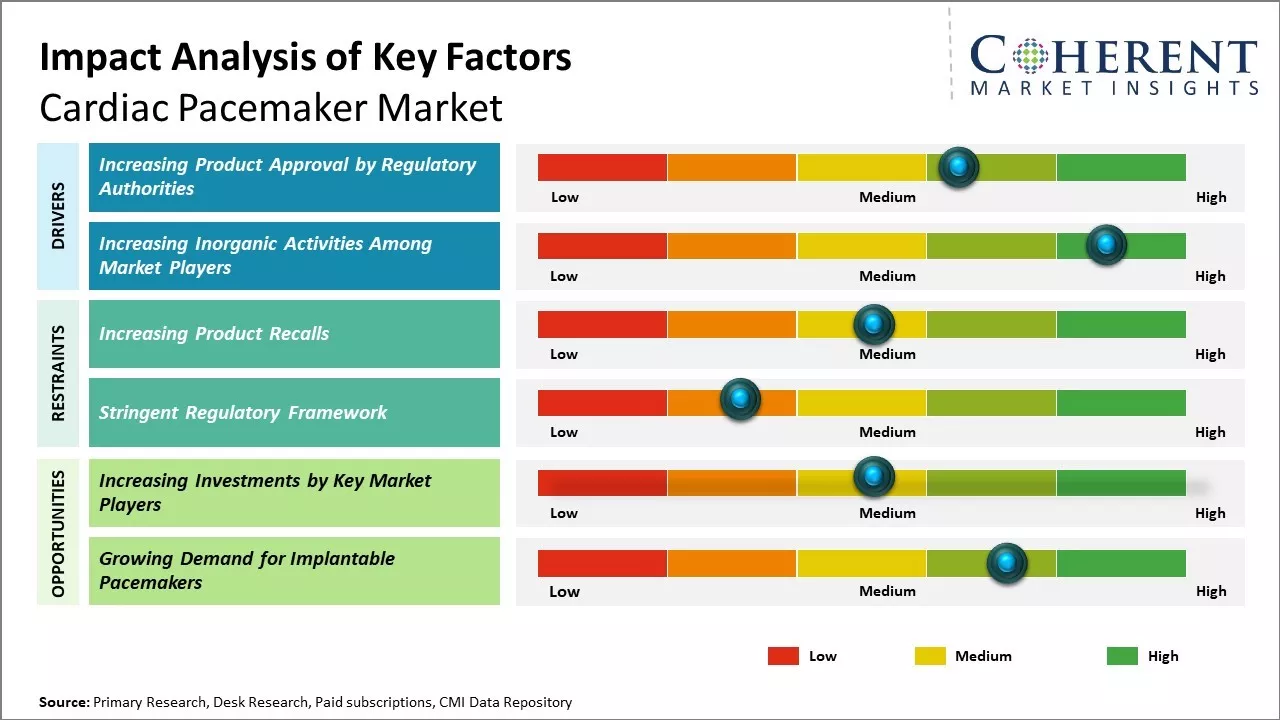
Discover market dynamics shaping the industry: Request sample copy
Global cardiac pacemaker market growth is driven by rising geriatric population worldwide and the subsequent increase in the prevalence of cardiovascular and heart diseases. Growing adoption of technologically advanced cardiac pacemakers integrated with remote monitoring capabilities can boost demand for these pacemakers. However, the availability of alternative therapies for arrhythmia syndromes and the risks and complications associated with pacemaker implants may hamper the cardiac pacemaker market growth during the forecast period.
Increasing product approval by regulatory authorities
Increasing product approval by regulatory authorities is expected to drive the global cardiac pacemaker market growth over the forecast period. For instance, on June 15, 2020, Medtronic plc., a medical device company, announced that it had received CE mark by European Union (EU) for Micra AV Transcatheter Pacing System (TPS), a small pacemaker with features such as atrioventricular (AV) synchrony. This device is indicated for treatment of patients with AV blocks, impaired heart chambers, to provide electrical signals for proper functioning of heart.
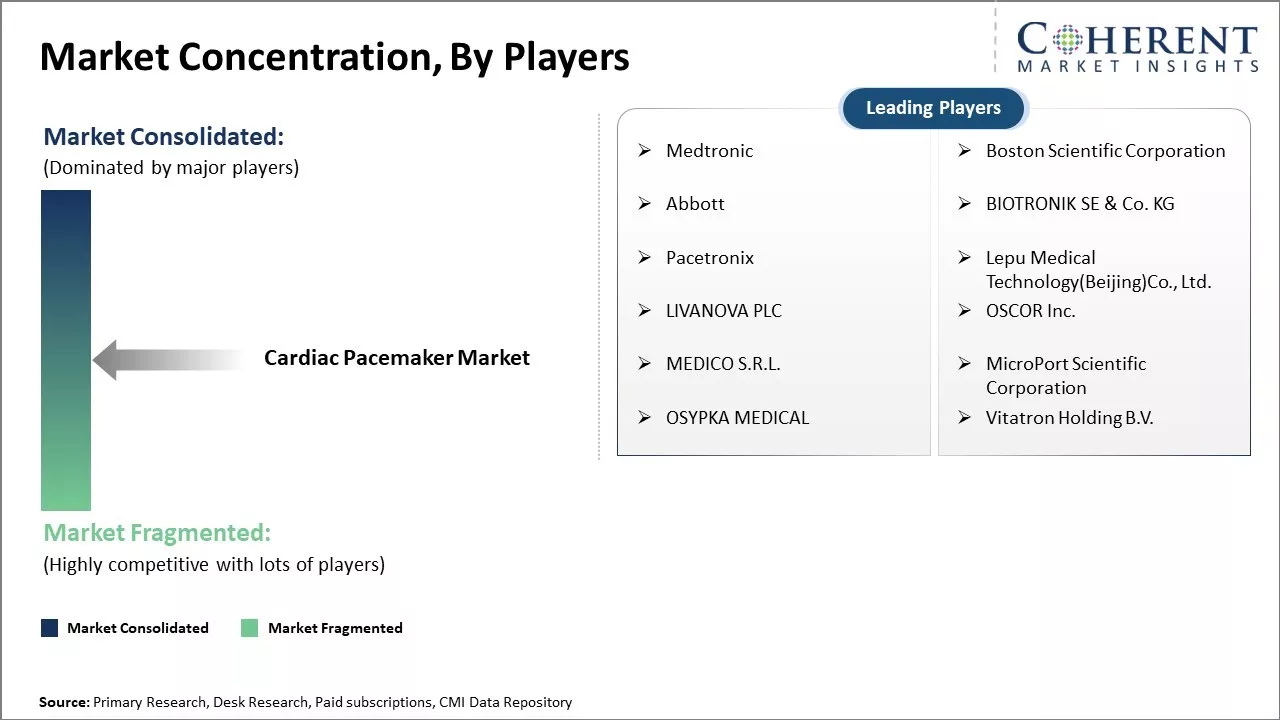
Get actionable strategies to beat competition: Request sample copy
Increasing inorganic activities among market playersIncreasing inorganic activities such as agreements, partnerships, and collaborations among market players is expected to drive the global cardiac pacemaker market growth over the forecast period. For instance, on December 17, 2021, LifeTech Scientific Corporation, a China-based medical device company and manufacturer of interventional medical devices, announced its extension of agreement with Medtronic plc., a medical devices company for HeartTone domestic pacemaker project. This project agreement includes extension of project till 2028, where Medtronic will provide series of specialized technical consulting services.
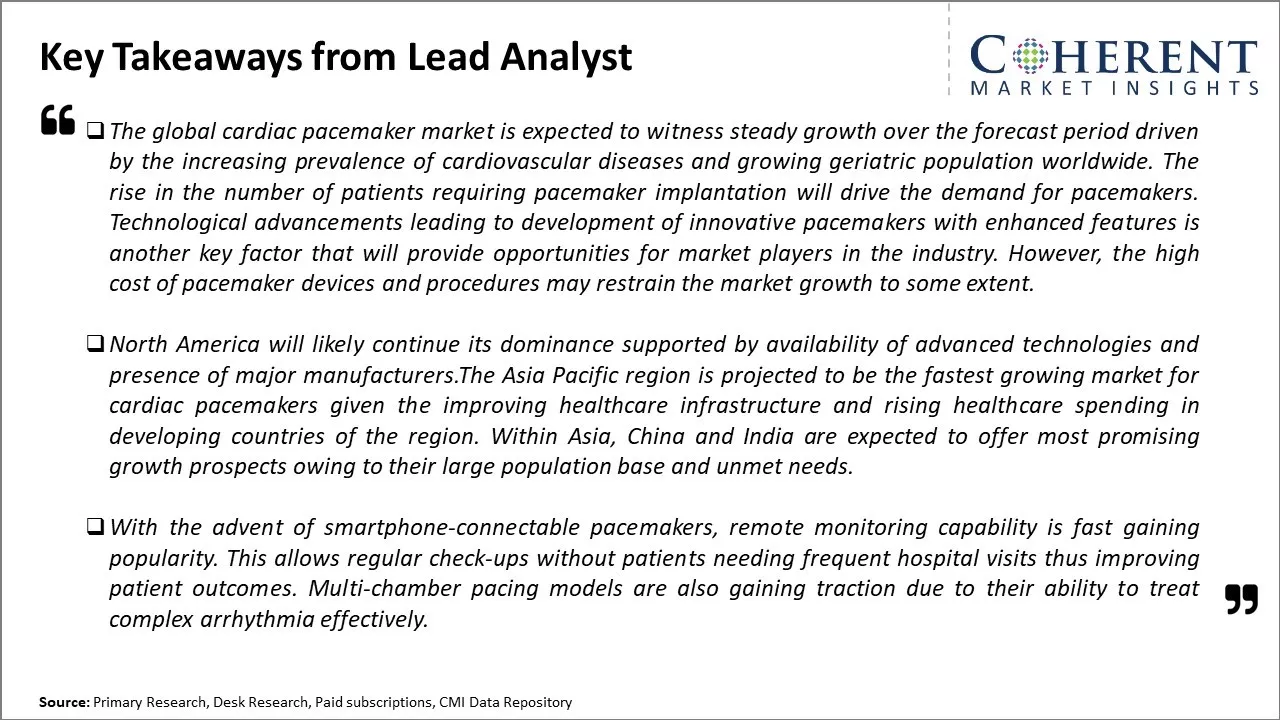
To learn more about this report, Request sample copy
Market Challenge – Increasing product recallsProduct recall for cardiac pacemakers by market players is expected to hamper the global cardiac pacemaker market growth over the forecast period. For instance, in August 2021, Boston Scientific, a medical device manufacturing company, announced the recalling notice for pacemakers and cardiac resynchronization therapy pacemakers (CRT-Ps) due to the risk of transitioning to safety mode. Safety mode is intended to provide backup if the device is faulty. These pacemakers or cardiac resynchronization therapy pacemakers (CRT-Ps) belongs to Boston Scientific’s INGENIO product portfolio, which are used for patients who have low heart rates, and patients with moderate to severe heart failure, a condition where heart cannot pump enough blood as per requirement for patient.
Market Opportunity – Increasing Investments by Key Market Players
Increasing adoption of inorganic growth strategies such as investments is expected to drive growth of the global cardiac pacemaker market. For instance, in July 2022, a research project at the University of Leeds U.K., announced that it had received a funding of US$ 214,328 grant from Heart Research UK to examine use of blood pressure cuffs for heart failure patients with pacemakers.
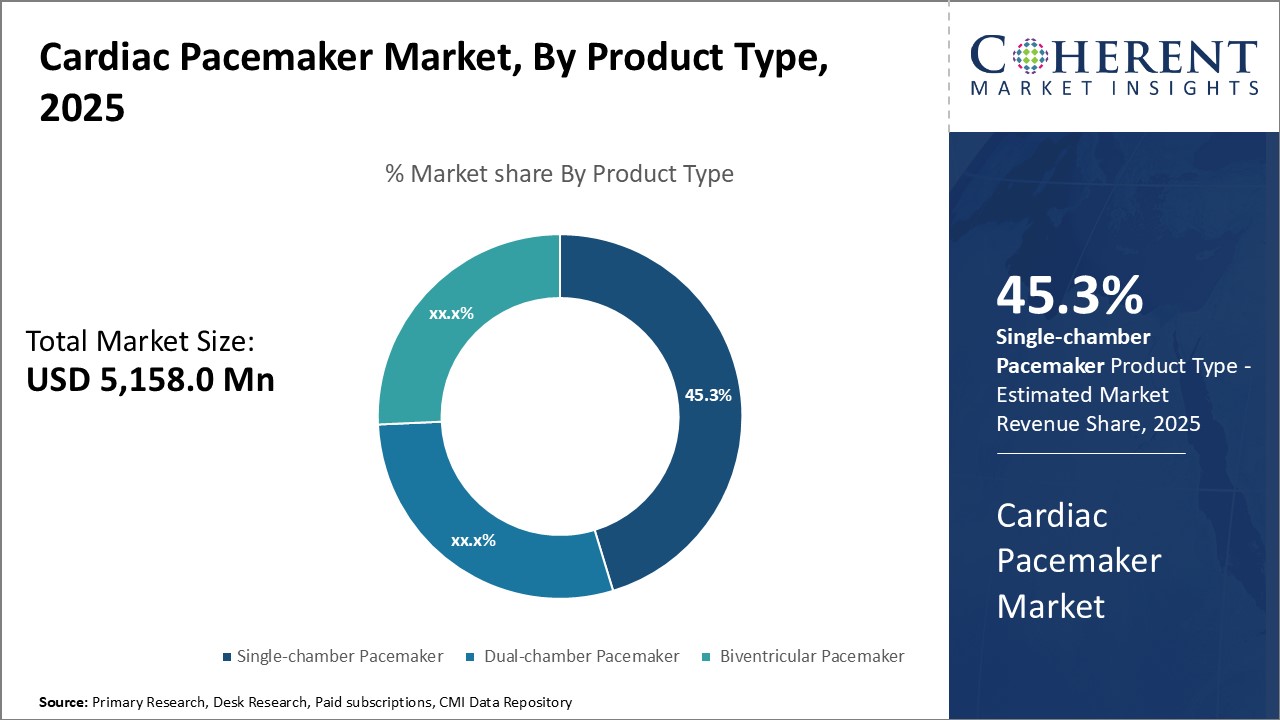
Discover high revenue pocket segments and roadmap to it: Request sample copy
Insights, By Product Type: Affordability boosts demand for single-chamber pacemakerProduct Type segment is sub-segmented into single-chamber pacemaker, dual-chamber pacemaker, biventricular pacemaker. Single-chamber pacemaker segment is estimated to hold 45.3% of the market share in 2025, owing to their affordable price point. Single-chamber pacemakers offer a more basic yet effective solution at a fraction of the cost of dual-chamber or biventricular models, thus, making them desirable for price-sensitive customers. Their simple design with only one lead wire also reduces manufacturing complexities and costs. Given the large population without health coverage, single-chamber pacemakers remain the go-to option for those seeking an affordable treatment option. This has ensured their continued dominance in the global cardiac pacemaker market over the years.
Insights, By Implantability: Clinical adaptability boosts usage of implantable pacemakers
Implantability segment is sub-segmented into implantable pacemakers and external pacemakers. Implantable pacemakers segment is estimated to hold 64% of the market share in 2025m owing to their enhanced clinical suitability and acceptance. Unlike external pacemakers used temporarily, implantable devices offer permanence once surgically placed inside the body. This allows for superior management of cardiac arrhythmias without restrictions on patient movement or lifestyle. Implantable pacemakers are also more seamlessly integrated with the body's physiology. Advancements in miniaturization have increased comfort levels while reducing risks of inflection and rejection. Their long-term reliability negates the need for frequent replacement. Widespread physician recommendation and training has boosted user familiarity and preference for implantable pacemakers over other options. This has established them as the gold standard treatment in most healthcare settings.
Insights, By End User: Hospital infrastructures drive demand from Hospitals
End User segment is sub-segmented into hospitals, cardiac clinics, ambulatory surgical centers. Hospitals segment is estimated to hold 33.6% of the market share in 2025 as most patients prefer dedicated cardiac facilities for pacemaker implantation and management. Hospitals employ skilled cardiac specialists, equip themselves with advanced diagnostic technologies and operate high-level intensive care units required for pacemaker procedures. These also offer post-operative care and monitoring at convenient locations. This provides patients assurance of comprehensive care. Many countries also lack widespread access to cardiac clinics or surgery centers in rural areas. Hospitals remain the default option for a majority, driving their sales volumes. Governments and insurance providers also prefer recognized hospital infrastructures for reimbursing cardiac device costs.
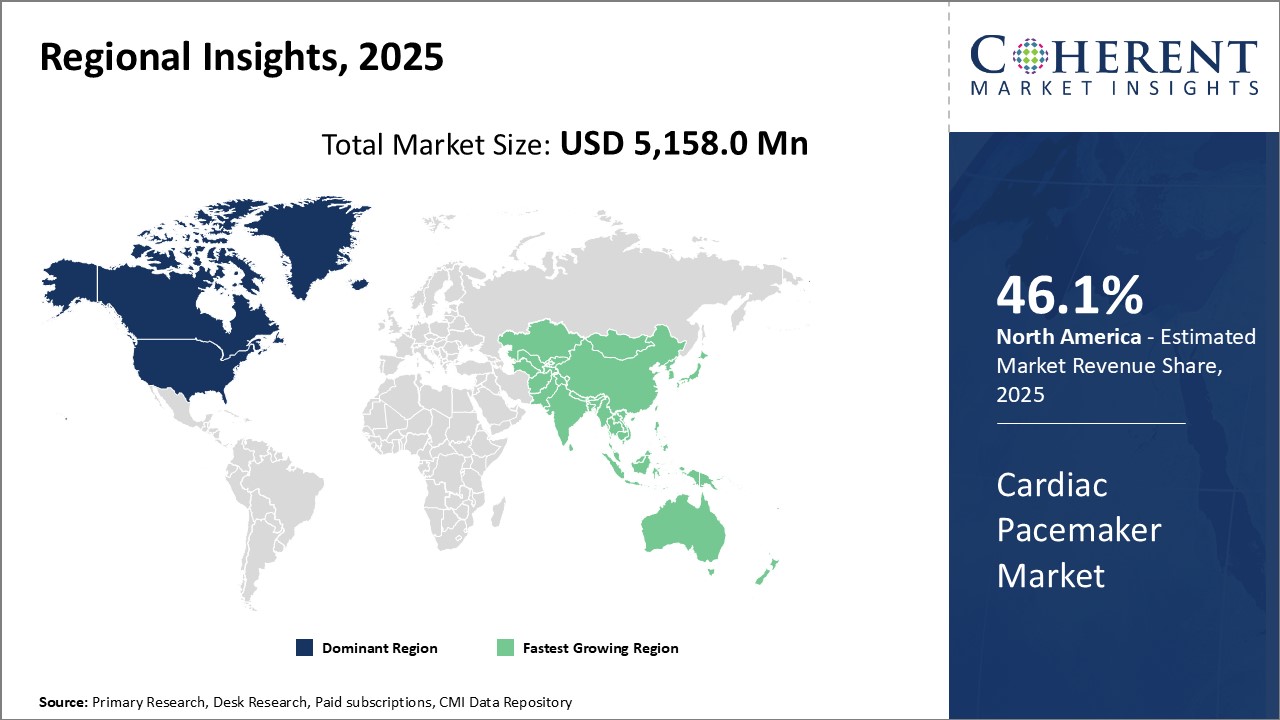
Need a Different Region or Segment? Customize now
North America remains the dominant region in the global cardiac pacemaker market and is estimated to hold 46.1% of the market share in 2025. The U.S. leads the regional market and accounts for the major share due to the strong presence of leading pacemaker manufacturers in the country. Factors such as rising geriatric population suffering from cardiovascular diseases, favorable reimbursement policies, and higher healthcare spending have boosted the sales of pacemakers in the US. The region is an early adopter of advanced devices due to the high acceptance of new technologies among physicians and patients. Leading global players such as Medtronic, Abbott, and Boston Scientific have their headquarters in the U.S., allowing them to cater to the regional demands efficiently and maintain their stronghold.
Asia Pacific has shown potential to become the fastest-growing region in the global market. China dominates the Asia Pacific cardiac pacemaker market due to rising incidence of cardiovascular diseases and growing healthcare expenditure. Moreover, the presence of a large patient pool makes the country highly lucrative for pacemaker manufacturers. With improving medical infrastructure and affordability, the adoption of pacemakers is increasing at a rapid pace in China.
Report Coverage
| Report Coverage | Details | ||
|---|---|---|---|
| Base Year: | 2024 | Market Size in 2025: | USD 5,158.0 Mn |
| Historical Data for: | 2020 To 2024 | Forecast Period: | 2025 To 2032 |
| Forecast Period 2025 to 2032 CAGR: | 5.1% | 2032 Value Projection: | USD 7,311.2 Mn |
| Geographies covered: |
|
||
| Segments covered: |
|
||
| Companies covered: |
Medtronic, Boston Scientific Corporation, Abbott, BIOTRONIK SE & Co. KG, Pacetronix , Lepu Medical Technology(Beijing)Co., Ltd., LIVANOVA PLC, OSCOR Inc., MEDICO S.R.L., MicroPort Scientific Corporation, OSYPKA MEDICAL, Vitatron Holding B.V. |
||
| Growth Drivers: |
|
||
| Restraints & Challenges: |
|
||
Uncover macros and micros vetted on 75+ parameters: Get instant access to report
*Definition: A cardiac pacemaker is a small-sized device that is implanted in the chest to control the slow heartbeat. The cardiac pacemaker implantation is carried out with a surgical procedure. There are three types of cardiac pacemakers such as single-chamber pacemaker, dual-chamber pacemaker, and biventricular pacemaker
Share
Share
About Author
Komal Dighe is a Management Consultant with over 8 years of experience in market research and consulting. She excels in managing and delivering high-quality insights and solutions in Health-tech Consulting reports. Her expertise encompasses conducting both primary and secondary research, effectively addressing client requirements, and excelling in market estimation and forecast. Her comprehensive approach ensures that clients receive thorough and accurate analyses, enabling them to make informed decisions and capitalize on market opportunities.
Missing comfort of reading report in your local language? Find your preferred language :
Transform your Strategy with Exclusive Trending Reports :
Frequently Asked Questions
Joining thousands of companies around the world committed to making the Excellent Business Solutions.
View All Our Clients
US Reciprocal Tax Impact Analysis On Cardiac Pacemaker Market
Stay updated on tariff changes with expert insights and timely information